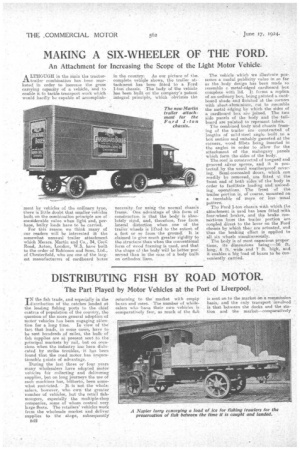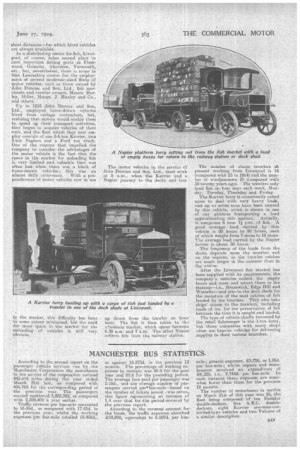DISTRIBUTING FISH BY ROAD MOTOR.
Page 26

Page 27

If you've noticed an error in this article please click here to report it so we can fix it.
The Part Played by Motor Vehicles at the Port of Liverpool.
TN the fish trade, and especially in the ..Litstribution of the catches landed at the leading fishing ports to the chief centres of population of the country, the question of the. more. general adciption of motor vehicles has been engaging attention for a long time. In view of the fact that load's, in some cases, have to be sent hundreds of miles, the bulk of fish supplies are at present sent to the principal markets by rail, but on occasions when the industry has been dislocated by strike troubles, it has been found that the road motor has unquestionable Toints of advantage.
During the. hist three or four years many wholesalers have adopted motor vehicles for collecting and deliVering supplies, but on long journeys the use of such machines has, hitherto, been somewhat restricted. It is not the wholesalers, however, who own the greater number of vehicle's, hut the retail fishmongers, especially the multiple-shop companies, some of whom control very large fleets. The retailers' vehicles work from the wholesale market and .deliver supplies to the shops, subsequently
B42
returning to the market with empty boxes and eases. The number of wholesalers who have their ownvehicles is comparatively few, as much of the fish
is sent on to the market On a commission basis, and the only transport involved is that between the docks and the station and the market—comparatively short distances—for which hired vehicles are always available.
As a distributing centre for fish, Liverpool, of [nurse, Sakes second place to such important fishing ports as Fleetwood, Grimsby, Aberdeen, Yarmouth, etc., but, nevertheless, there is scope in that Lancashire centre for the employment of several moderate-sized fleets of motor vehicles, such as those owned bY 'John Duncan and Son, Ltd., fish merchants and trawler owners, Messrs. Harley, Miller, Messrs. 3. Huxley and Co., and others.
lip to 1919 Joho Duncan and Son, Ltd., •oinploved horse-drawn vehicles hired from cartage contractors, but, realizing that motors would enable them to speed up their transport • activities, they began to acquire vehicles of their own, and the fleet which they now employ consists of one 5-6••ton Kwarrier, two 2-ton TCapiers and a Fotd ton truck. One of the reasons that impelled the company to, consider the advantages of the .motor vehicle is the fact that the space in the market for unloading fish is very limited and valuable time was often lost when there was a block of horse-drawn vehicles; this was an almost chill occurrence. With a preponderence of motor vehicles now in use
in the market, this difficulty has been to some extent minimised, but the need fOr more space in the market for the unloading of vehicles is still very 'obvious,
The motor vehicles in the service of John Duncan and Son, Ltd., start work at 5 a.m., when the 'Carrier and a Napier journeyto .the 'docks and Igoe u p direct from the trawler an hour iater.. The fish is then taken to the wholesale market, Which opens between 6.30 a.m. and Ta.M. The other Napier" collects fish from the railway station. The number of steam trawlers at present working from Liverpool is 14 (compared with 23 in 1914y and the number of windjammers 1\0 (compared witi4 30 twenty years ago). The trawlers only land fish an fotir days reach ,week, Monday," Tuesday, Thursday and Friday.
The Kartier lorry is occasionally called upon to deal with very heavy loads, and up to seven tons have been carried by this vehicle, which is shewn in one of our pictures transporting a -load approximating this amount. Actually, it comprises 6 tons 7i cwt. of fish. A good -average load Ca,rried by this vdhicie is 80.boxes to 90 boxes, each of which weighs from 7 stone to 12 stone. The average load carried by the Napier lorries is about 30 boxes.
The frequency of the loads from the docks depends upon the weather and on the seasons, as the trawler catches are much larger in the summer than in the winter.
After the Liverpool fish market has been supplied with its requirements, the Company's vehicles collect the empty boxes and cases and return them to the stations—i.e., Brunswick, Edge Hill and Waterloo—and also to the dock sheds for the reception of the next catches of fish landed by the trawlers. They also take ships' stores to the trawlers, including • loads of ice, for the preservation of fish between the time it is caught and landed.
The type of vehicle chiefly fa,vourod by the retail fishmonger is the 1-ton lorry, but those companies with many shops often use heavier vehicles for delivering supplies to their various branches.
































